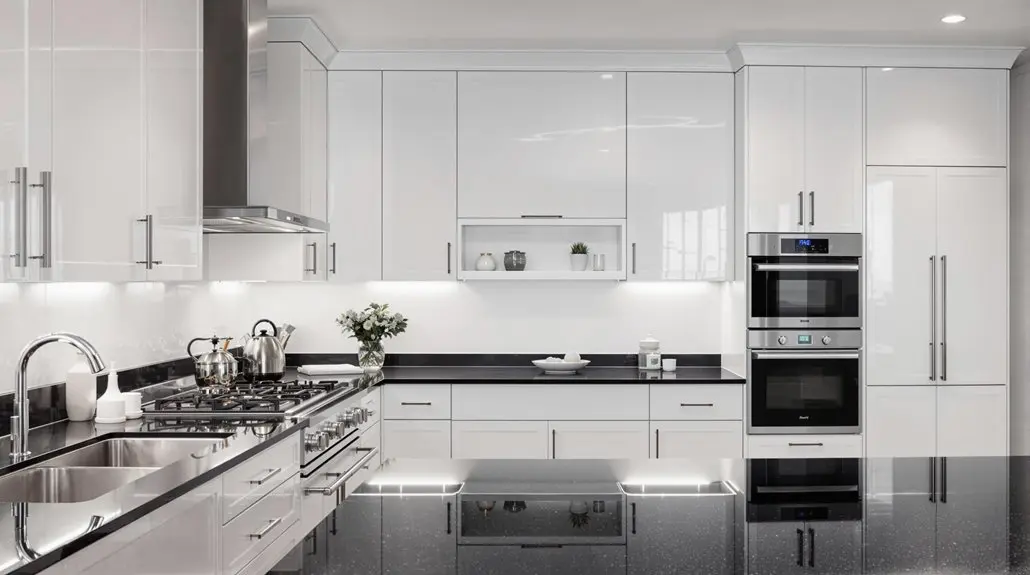
14 White Kitchen Cabinets With Black Countertops That Create Contrast
White kitchen cabinets paired with black countertops create a sophisticated, high-contrast foundation ideal for both modern and classic kitchens. Layering elements like brass hardware, bold black tile backsplashes, or warm wood accents introduces visual richness and depth. Minimalist layouts without upper cabinets maximize spatial openness, while integrated sinks and statement lighting polish the look. Each of the fourteen approaches builds unique character, ensuring versatile, customized design possibilities that await discovery in the following recommendations.
Key Takeaways
- Brass or gold hardware adds warmth and sophistication, enhancing the contrast between white cabinets and black countertops.
- Black or charcoal tile backsplashes amplify drama and create a striking focal point against white cabinetry.
- Omitting upper cabinets maximizes openness, letting black countertops and white lowers become the kitchen’s visual centerpiece.
- Warm wood accents, like stools or shelving, soften the contrast and introduce inviting texture to monochromatic kitchens.
- Statement black fixtures or lighting anchor the space and emphasize the bold interplay between black and white elements.
Pairing Black Countertops With Warm Wood Accents
How can designers achieve both visual depth and warmth in a kitchen defined by white cabinetry and black countertops? The strategic integration of warm wood accents offers an expert solution, introducing tactile richness and balancing the stark contrast inherent in monochromatic schemes. By incorporating elements such as a reclaimed wood dining table, open shelving, or bar stools in natural wood tones, designers foster a layered aesthetic that softens the boldness of black countertops. This nuanced interplay not only enhances visual interest but also creates a seamless shift between cabinetry and surfaces. The organic texture of wood infuses the kitchen with warmth and a sense of cohesion, accommodating a range of interior styles—from sleek modern to rustic farmhouse—while maintaining functionality and inviting ambiance within the space. For an added touch, light wood countertops can be integrated to enhance the inviting ambiance and balance the starkness of white cabinetry, bringing together modern elegance and natural beauty.
Enhancing Elegance With Brass Hardware
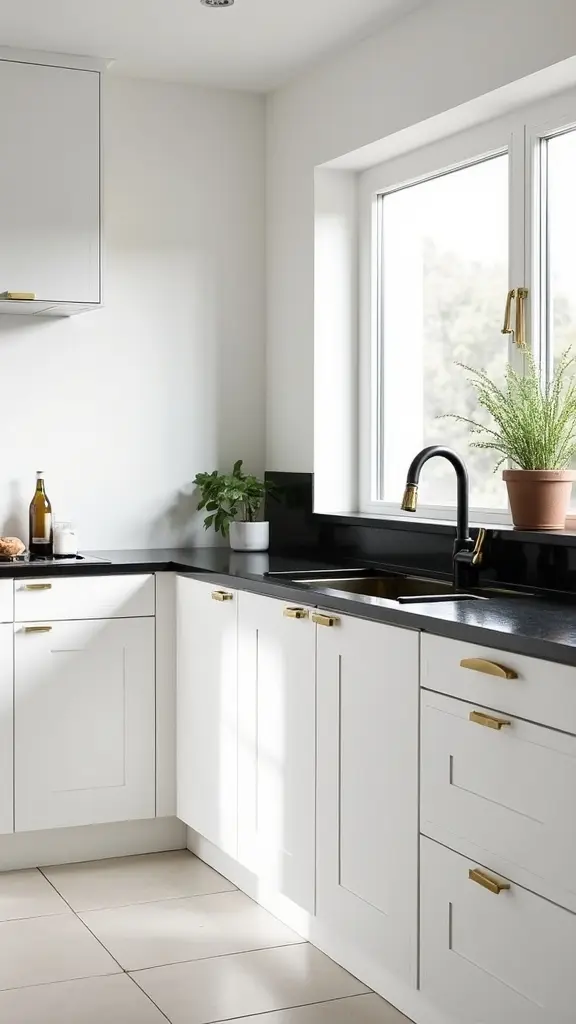
When seeking to enhance the sophistication of a kitchen defined by white cabinetry and black countertops, designers frequently turn to brass hardware as a strategic accent. The golden undertones of brass pulls and knobs introduce a layer of warmth, offsetting the stark contrast inherent in black and white kitchens. This metallic element not only adds visual interest but also raises the overall design, creating a seamless bridge between classic and contemporary aesthetics. Brass hardware’s adaptability guarantees it complements various styles, from minimal modernity to traditional refinement, while unifying other metallic details such as lighting fixtures or appliances. For enduring brilliance, regular maintenance—specifically polishing—preserves the luster of brass, assuring the hardware consistently enhances the kitchen’s elegance and sustains its inviting, timeless appeal through everyday use. Additionally, incorporating black cabinets paired with gold handles enhances visual appeal and adds a luxurious touch, ensuring the kitchen remains a sophisticated and opulent space.
Embracing Minimalism by Skipping Upper Cabinets
A minimalist kitchen aesthetic is effortlessly achieved by forgoing upper cabinets, resulting in a visually expansive and uncluttered environment. This strategic omission maximizes the perception of space, making it an ideal solution for compact or modern interiors.
The interplay of white cabinets with black countertops becomes the focal point, as the absence of upper cabinetry allows the contrasting surfaces to command attention and enhance the room’s linearity. Glossy white tile backsplashes further amplify light, contributing to a heightened sense of openness characteristic of minimalist design.
Without upper cabinets, homeowners are encouraged to implement innovative storage—such as streamlined open shelving or curated displays—that maintains both function and visual harmony. This approach not only simplifies maintenance but also reinforces the kitchen’s clean, contemporary, and highly functional aesthetic.
Making a Statement With a Black Tile Backsplash
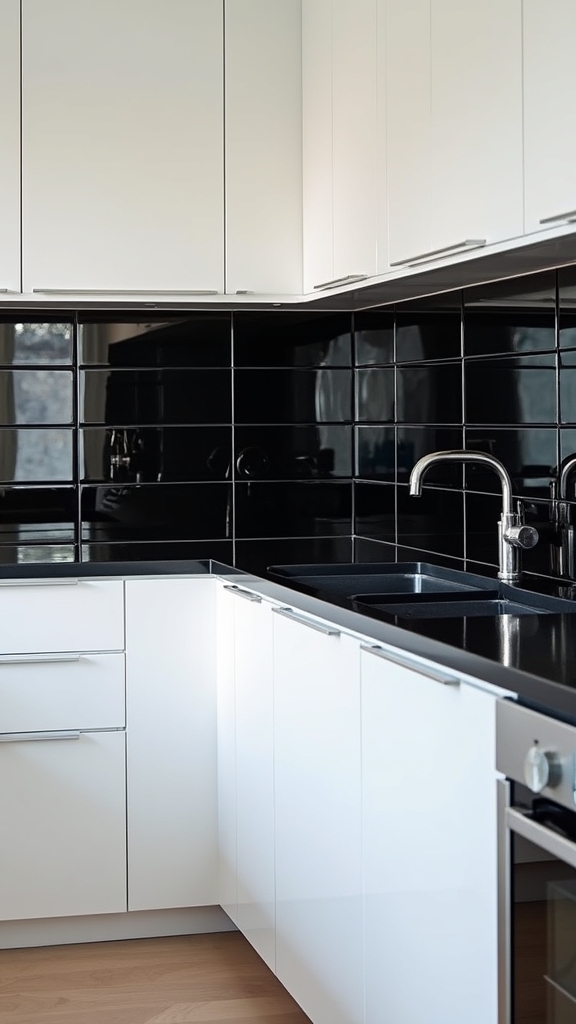
A black tile backsplash introduces dramatic visual contrast, amplifying the sophistication of white kitchen cabinets and black countertops. By balancing light and dark elements, this design solution enhances spatial perception while anchoring the overall palette. Additionally, the inherent durability and easy-to-clean surface of black tiles provide a practical advantage for high-use kitchen environments. Incorporating brushed metal hardware adds a refined modern touch to the kitchen design.
Dramatic Visual Impact
Few design elements rival the visual drama achieved by incorporating a black tile backsplash against white kitchen cabinets. This juxtaposition creates a compelling contrast that immediately commands attention.
Glossy black tiles serve a dual purpose: they reflect ambient light to amplify spatial depth while accentuating the sleek lines of the cabinetry. In open-concept kitchens, a black tile backsplash clearly delineates the culinary zone, establishing a sophisticated focal point amidst adjacent living spaces.
The interplay between white kitchen cabinets, black countertops, and a bold backsplash is highly versatile, seamlessly accommodating various countertop materials from white marble to black quartz. For added refinement, designers often select matte or textured black tiles, introducing nuanced visual interest and elevating the kitchen’s overall aesthetic with a sense of tailored sophistication.
Balancing Light and Dark
Many contemporary kitchen designs masterfully leverage the interplay of light and dark by introducing a black tile backsplash against white cabinetry. This deliberate contrast anchors the visual narrative of a black kitchen, transforming the backsplash into a bold focal point that accentuates the crispness of white cabinets.
Glossy black tiles enhance ambient light by reflecting it, ensuring the space remains luminous without sacrificing a modern, sophisticated edge. Alternatively, matte or textured black tiles introduce depth and tactile interest, elevating the design’s complexity.
The strategic use of a black tile backsplash not only defines kitchen zones in open-plan layouts but also achieves aesthetic cohesiveness. Additionally, this approach harmonizes seamlessly with various countertop materials, ensuring the balance between light and dark elements remains both striking and refined.
Easy Maintenance Benefits
Selecting a black tile backsplash introduces not only a visually arresting contrast to white kitchen cabinets but also a robust solution for effortless upkeep in high-traffic culinary spaces.
Black tiles, renowned for their easy-to-clean surfaces, minimize visible smudges and stains, making them a practical asset in busy kitchens. Their glossy finishes reflect ambient light, enhancing brightness while delivering a refined, contemporary look.
Customization options in texture and pattern allow tailored aesthetics without sacrificing the inherent low-maintenance advantage of ceramic or glass black tiles. This material choice is both functional and stylish, ensuring that kitchen spaces remain pristine with minimal effort.
- Conceals common kitchen stains and spills
- Requires minimal cleaning to maintain appearance
- Offers durable resistance to wear and moisture
- Enhances design with customizable textures and finishes
- Delivers a professional, polished backdrop
Adding Luxury With Black Marble Countertops
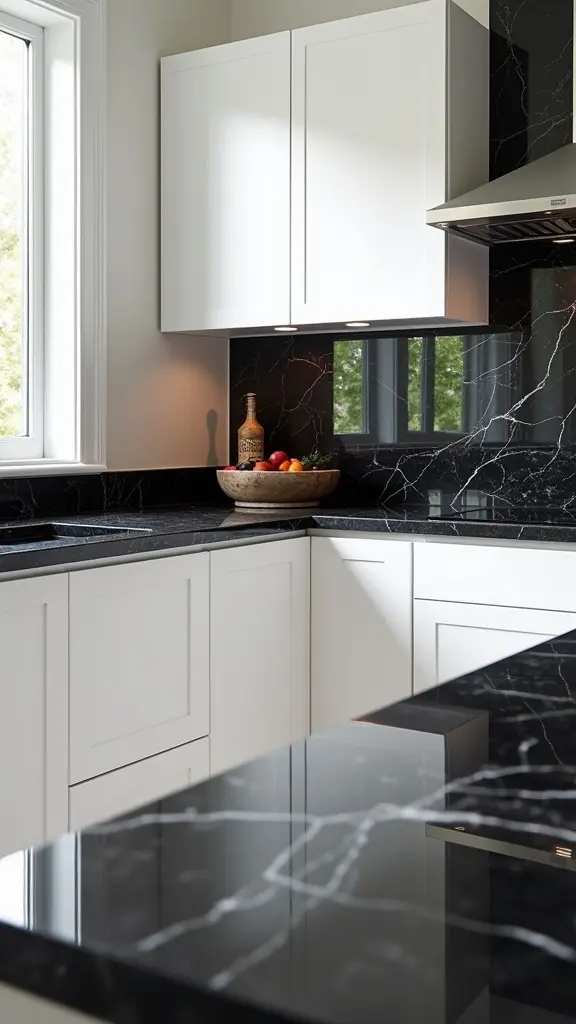
While white cabinetry establishes a crisp and inviting foundation, the addition of black marble countertops with distinctive white veining introduces an immediate sense of luxury and sophistication. The interplay between black marble and white cabinets generates visual drama, elevating the kitchen’s aesthetic to a bespoke, designer level. The inherent durability and heat resistance of black marble guarantee not only enduring beauty but also practical functionality for culinary tasks. Gold hardware remains a popular choice in kitchen design, beautifully complementing the contrast between white cabinets and black countertops. The reflective surface of black marble amplifies brightness, allowing white cabinets to appear even more luminous. This pairing is an ideal solution for homeowners seeking timeless elegance and a visually commanding kitchen space.
Creating a Seamless Look With Integrated Sinks

A seamless kitchen design is achieved through the integration of sinks directly into black countertops, especially when paired with white cabinetry.
Integrated sinks deliver a streamlined, contemporary appearance by eliminating visible seams and connections between the sink and countertop. This approach not only improves the visual harmony of the kitchen but also enhances practical aspects such as ease of maintenance.
Utilizing the same black stone or composite material for both the integrated sink and countertops guarantees a unified, minimalist aesthetic.
Key advantages include:
- Continuous surface reduces visual clutter.
- Apron-front integrated sinks serve as a striking focal point.
- No gaps for debris, promoting superior hygiene.
- Material consistency ensures seamless blending.
- Enhanced functionality meets modern minimalist standards.
Integrated sinks with black countertops offer a best balance of elegance and utility.
Unifying Design With a Matching Kitchen Island
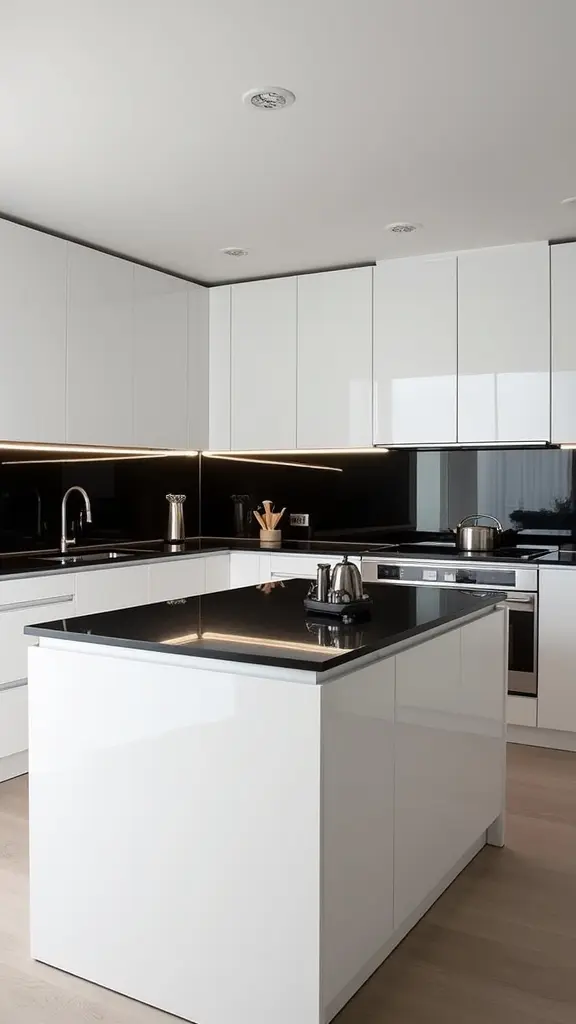
By incorporating a kitchen island that features the same black countertop material as the surrounding work surfaces, the design achieves an enhanced sense of cohesion between the crisp white cabinetry and the dramatic countertops. This strategic use of matching black countertops on the kitchen island not only amplifies visual unity but also delineates the kitchen’s core functions. The island becomes a centralized anchor, offering expanded workspace and social seating while reinforcing the striking contrast fundamental to this design scheme. Consistent materiality across all surfaces streamlines the aesthetic, delivering a polished, purposeful ambiance suitable for both modern and traditional settings. Double kitchen islands can also enhance homes’ resale value significantly, appealing to contemporary buyers and increasing market demand.
| Unity | Functionality | Emotion |
|---|---|---|
| Seamless flow | Extra workspace | Inviting warmth |
| Balanced look | Casual seating | Modern elegance |
| Coordinated style | Defined zones | Refined drama |
| Visual anchor | Multi-use surface | Lasting impact |
Soften the Contrast With Off-White Cabinetry
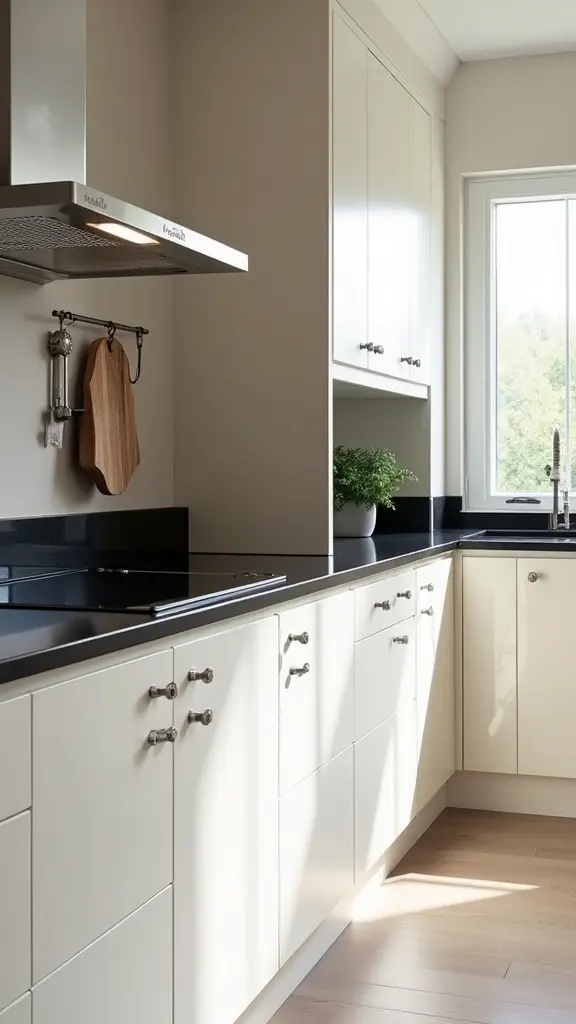
Opting for off-white cabinetry introduces subtle color variations that effectively soften the stark contrast with black countertops.
By selecting shades with cream or gray undertones, designers can enhance the warmth and visual interest of the space.
This approach delivers a balanced, inviting aesthetic while maintaining adaptability across diverse kitchen styles.
Embrace Subtle Color Variations
While the classic black-and-white pairing delivers striking visual impact, integrating off-white cabinetry introduces a nuanced approach that refines the kitchen’s overall aesthetic.
Subtle color variations—such as cream or pale grayish-white—bring a softened contrast to black countertops, establishing a more harmonious and inviting atmosphere. This approach is particularly effective in compact spaces, where lighter cabinetry visually expands the room while still allowing for dramatic black surfaces.
Off-white cabinetry’s versatility complements a spectrum of black countertop materials, from matte finishes to richly veined marble, ensuring a sophisticated, layered look.
- Enhances depth with nuanced visual interest
- Softens the starkness of pure white and black
- Pairs seamlessly with various black countertop textures
- Creates an illusion of spaciousness in smaller kitchens
- Facilitates a cohesive, elegant design narrative
Enhance Warmth With Undertones
Although a classic black-and-white palette exudes sophistication, introducing off-white cabinetry with subtle undertones offers a refined solution for softening the stark contrast often associated with this color scheme.
Off-white, whether possessing creamy or grayish undertones, mediates the visual tension between crisp white and deep black countertops, fostering a more inviting and harmonious kitchen environment. This nuanced approach not only warms the overall aesthetic but also integrates seamlessly with various decorative elements, allowing for broader flexibility in accent color selection.
Additionally, off-white cabinetry contributes to the perception of spatial expansion, making compact kitchens appear larger without sacrificing the timeless appeal of black countertops.
The resulting interplay of gentle undertones and bold surfaces achieves a versatile design, adaptable to both contemporary and traditional kitchen styles.
Incorporating a Built-In Banquette for Functionality
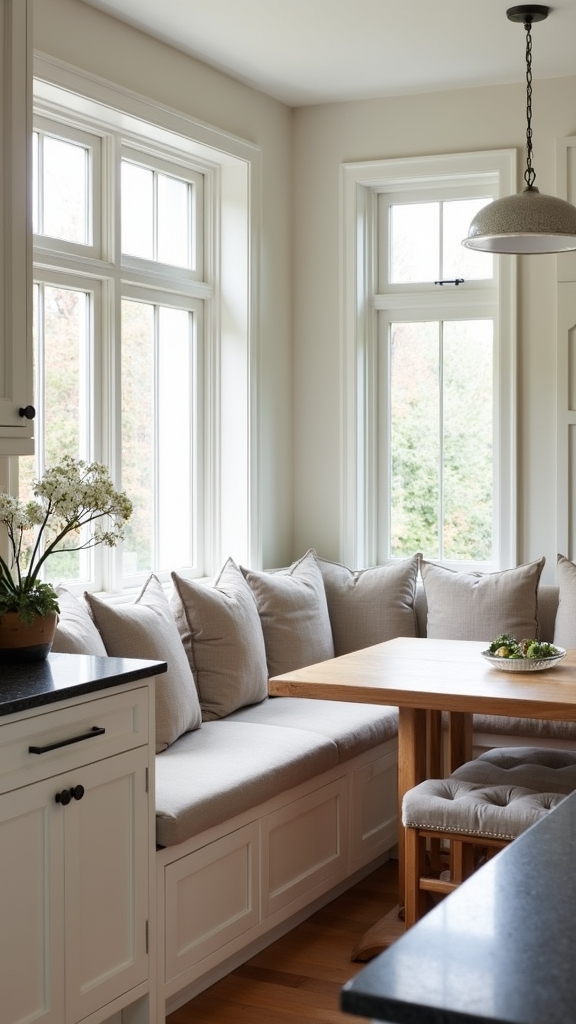
Many contemporary kitchen designs benefit from the integration of a built-in banquette, especially when working with white cabinetry and black countertops. A banquette not only maximizes spatial efficiency but also enhances the kitchen’s usability by providing additional seating and a welcoming eat-in area.
When tailored with white finishes and black leather cushions, the banquette seamlessly complements black countertops, reinforcing the room’s visual harmony. This approach is particularly advantageous in compact kitchens, where every inch counts.
To further improve both function and design, consider the following:
- Echo cabinetry details in the banquette’s construction
- Coordinate table surfaces with black countertops for cohesion
- Add decorative pillows for comfort and style
- Opt for built-in storage beneath seating
- Select durable, easy-to-clean upholstery
This integration achieves a sophisticated, unified kitchen environment.
Introducing Scandinavian Style Elements
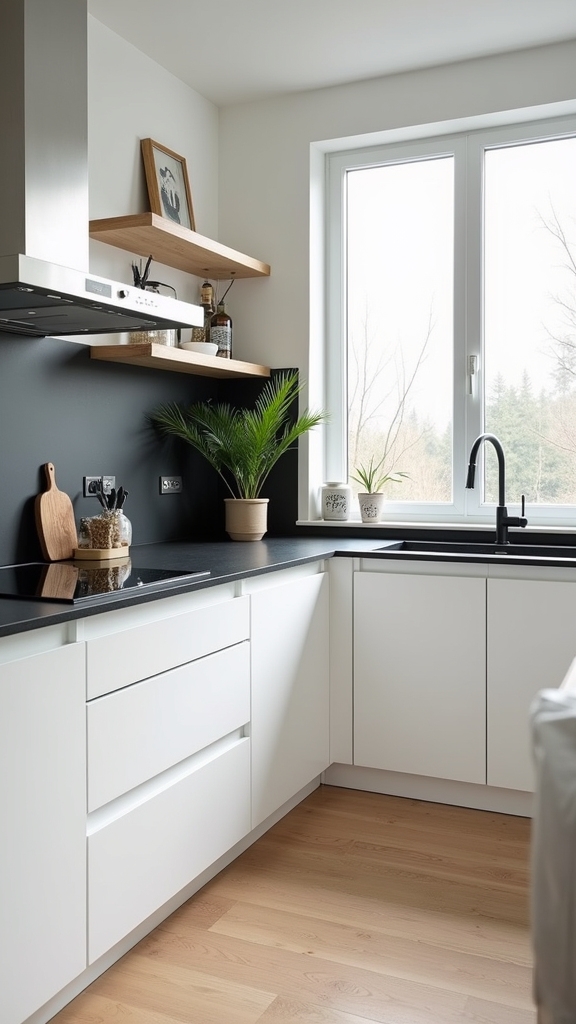
A minimalist color palette forms the foundation of Scandinavian-inspired kitchens, offering visual tranquility amid the crisp contrast of white cabinetry and black countertops.
Streamlined cabinet hardware, such as matte black or brushed nickel pulls, reinforces this understated aesthetic while enhancing functionality.
Together, these elements achieve a harmonious balance between simplicity and modern sophistication in kitchen design.
Minimalist Color Palette
By embracing a restrained color palette, Scandinavian-inspired kitchens achieve a refined interplay between white cabinetry and black countertops, resulting in a visually striking yet harmonious environment.
This minimalist approach amplifies spatial perception and natural luminosity, while the deep tone of black countertops anchors the otherwise ethereal effect of white cabinets.
The scheme’s sophistication lies in its balance—subtle additions of natural materials and muted hues guarantee warmth without overwhelming the senses.
To optimize this aesthetic, designers often recommend the following strategies:
- Integrate organic wood accents for tactile warmth
- Employ soft gray accessories to soften shifts
- Prioritize simple, unembellished cabinet profiles
- Select matte or satin finishes for a modern edge
- Maintain decluttered surfaces to accentuate contrast
Such principles yield a timeless, effortlessly adaptable kitchen design.
Streamlined Cabinet Hardware
Streamlined cabinet hardware, characterized by minimalistic forms and functional detailing, serves as a cornerstone of Scandinavian kitchen design. In a black and white kitchen, the use of unobtrusive pulls and knobs in matte or brushed metal finishes—often stainless steel or matte black—reinforces a cohesive, uncluttered aesthetic. The following table presents key attributes of Scandinavian-style cabinet hardware:
| Feature | Design Impact |
|---|---|
| Minimalistic Profiles | Enhances visual clarity |
| Functional Detailing | Supports user experience |
| Matte/Brushed Finishes | Complements contrast |
These hardware solutions maintain the refined balance between function and form. Streamlined cabinet hardware not only accentuates the dramatic contrast between white cabinets and black countertops but also upholds the practical ethos of Scandinavian design—delivering spaces that are both aesthetically modern and highly functional.
Highlighting With Silver Tones and Stainless Steel

Silver tones and stainless steel elements introduce a refined, contemporary edge to kitchens featuring white cabinetry and black countertops. These finishes serve not only as essential functional assets but also as deliberate style statements. Stainless steel appliances provide a sleek, uninterrupted flow between the black and white palette, reinforcing the modern aesthetic. Meanwhile, silver-toned hardware, such as cabinet pulls and knobs, delivers understated sophistication and cohesiveness across the design. The reflective nature of stainless steel maximizes ambient light, counterbalancing the visual weight of black countertops while enhancing spatial brightness. Light greige tones foster a calming and inviting environment, contributing to a welcoming atmosphere in the kitchen. Key strategies include:
- Incorporating stainless steel appliances for seamless integration
- Selecting silver-toned cabinet hardware for unity
- Utilizing metallic light fixtures for accentuation
- Adding silver decorative accents for cohesion
- Utilizing reflective surfaces to amplify natural illumination
Using Charcoal Shades for Depth
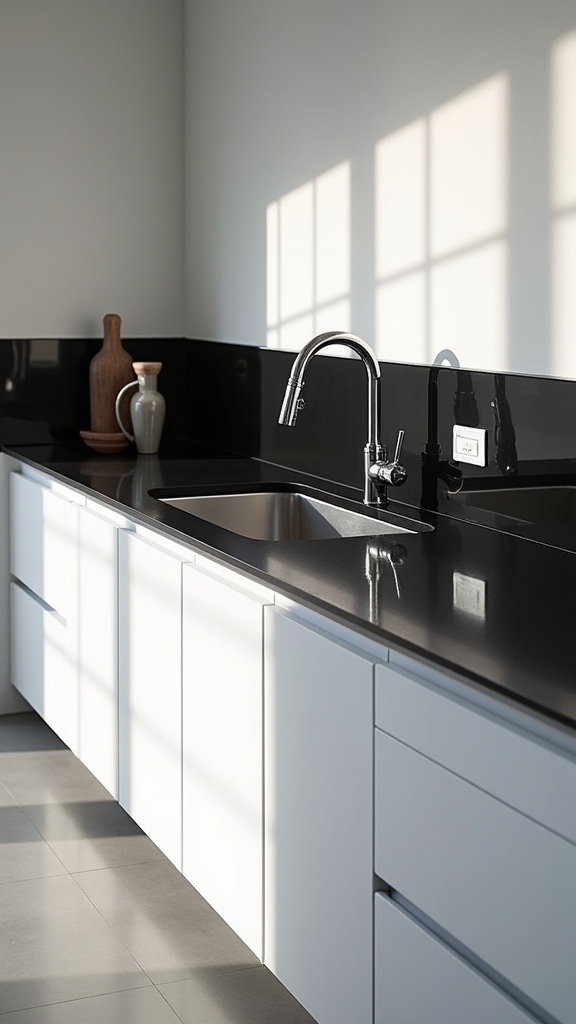
A nuanced approach to kitchen design involves selecting charcoal shades for countertops, offering a sophisticated alternative to stark black surfaces. Charcoal shades introduce depth and warmth, softening the high-contrast interplay between white cabinetry and darker surfaces. This subtle variation enhances visual complexity, allowing for refined contrast without dominating the overall aesthetic. Expertly chosen charcoal countertops often feature gentle veining or textured finishes, providing understated interest and tactile appeal. The adaptability of charcoal shades complements a broad spectrum of design languages—from crisp modern minimalism to rustic farmhouse sensibilities—while supporting seamless integration with additional material accents such as wood or metal. Incorporating natural stone backsplashes alongside charcoal countertops can further enhance the tactile quality and earthy tones, contributing to a cohesive and inviting rustic kitchen environment. This solution-oriented selection enables designers to maintain contrast and cohesion simultaneously, producing a balanced kitchen environment that feels both inviting and architecturally resolved.
Establishing a Focal Point With Bold Fixtures
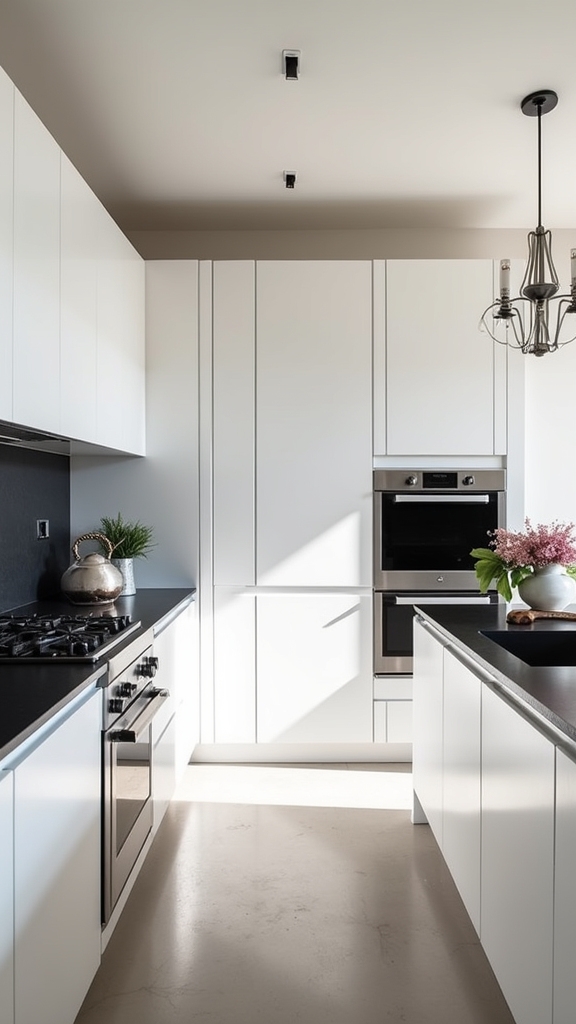
Frequently, the introduction of bold fixtures serves as a strategic design maneuver to anchor visual interest within kitchens characterized by white cabinetry and black countertops.
By selecting fixtures that diverge in scale, finish, or form, designers can create a compelling focal point that both complements and boosts the inherent contrast of the space.
Oversized or uniquely contoured fixtures—such as sculptural pendant lights or avant-garde faucets—command attention and disrupt monotony, while their placement over functional zones maximizes both utility and aesthetic impact.
The curation of bold fixtures with contrasting finishes, such as matte black or polished brass, further reinforces the dynamic interplay between light and dark elements.
- Draws the eye to key zones
- Enhances spatial drama
- Amplifies the contrast motif
- Provides functional illumination
- Expresses individual design intent
Layering Black Accents Throughout the Space

Layering black accents throughout the kitchen involves thoughtfully coordinating hardware and fixtures to reinforce the black-and-white palette. Selecting a contrasting backsplash and flooring guarantees visual continuity while preventing monotony. Statement lighting choices with black finishes can anchor the space and unify disparate design elements. Incorporating black steel fixtures adds luxury and depth, complementing the overall design aesthetics.
Coordinating Hardware and Fixtures
While the visual contrast between white kitchen cabinets and black countertops establishes a compelling foundation, the thoughtful coordination of hardware and fixtures enhances the overall design.
Selecting cabinets with black hardware introduces a deliberate repetition of dark accents, reinforcing the kitchen’s modern sophistication. Integrating black faucets, light fixtures, and appliances creates a curated continuity, linking disparate elements for a cohesive aesthetic.
Strategic layering of black accents in seating or décor further amplifies the interplay between cabinetry and countertops. For precision in design execution, consider:
- Black cabinet pulls and knobs for crisp, graphic detailing
- Matte black faucets to echo countertop tones
- Coordinated black appliances for a seamless, streamlined look
- Black-framed lighting or pendants as architectural statements
- Black window or door trim to unify connections and enhance contrast
This solution-oriented approach guarantees lasting visual harmony.
Contrasting Backsplash and Flooring
When curating a kitchen with white cabinets and black countertops, the introduction of a contrasting backsplash and thoughtfully selected flooring becomes essential for elevating visual impact and design continuity.
Employing a contrasting backsplash—such as black tiles or patterned black and white motifs—not only reinforces the dramatic interplay between cabinetry and countertops but also serves as a striking focal point.
Utilizing black tiles in the flooring, or opting for dark-stained hardwood, anchors the kitchen and visually ties together disparate surfaces.
Strategic use of dark grout with white tiles in the backsplash increases graphic definition, lending a contemporary edge.
Statement Lighting Choices
Statement lighting emerges as a pivotal design element in kitchens featuring white cabinets and black countertops, providing both functional illumination and a sophisticated layer of visual contrast. Expertly chosen black-accented fixtures—such as pendant lights or bold chandeliers—reinforce the dramatic interplay between light and dark surfaces, while also serving as sculptural focal points.
Integrating black accents through lighting and decorative objects establishes a cohesive visual language, unifying the kitchen’s disparate elements. For ideal effect, designers recommend the following strategies:
- Select black-finished statement lighting to echo the countertop’s depth.
- Use geometric or modern fixture designs for contemporary flair.
- Opt for dimmable LEDs to adjust ambiance as needed.
- Incorporate black decorative accessories to enhance layering.
- Position lighting to highlight the cabinetry-countertop contrast.
This approach guarantees a visually engaging, harmonious kitchen.
Frequently Asked Questions
Do White Cabinets Go With Black Countertops?
Pairing white cabinets with black countertops is a solution-oriented approach that enhances kitchen aesthetics through color harmony. This expert-recommended combination delivers visual balance, depth, and timeless appeal, accommodating various design styles while maintaining enduring sophistication and versatility.
What Color Should I Paint My Cabinets With a Black Countertop?
When considering cabinet color options with a black countertop, designers recommend exploring contrasting hues such as crisp white, soft cream, light gray, or bold navy. These choices enhance visual interest, introduce warmth, and guarantee a balanced, sophisticated kitchen aesthetic.
How to Brighten a Kitchen With Black Countertops?
To brighten a kitchen with black countertops, designers recommend maximizing kitchen lighting through pendant fixtures or under-cabinet LEDs. Selecting reflective countertop materials and incorporating light-colored surfaces, backsplashes, and accessories further enhances luminosity and visual balance within the space.
How to Make a Black and White Kitchen Feel Warm?
To make a black and white kitchen feel warm, designers recommend integrating cozy accents through plush textiles, infusing warm lighting for ambiance, and selecting natural materials or metallic finishes to soften the palette, achieving a welcoming, harmonious environment.
Conclusion
White kitchen cabinets paired with black countertops offer a timeless, high-contrast foundation adaptable to any design vision. Expertly integrating elements like warm wood, bold backsplashes, or metallic hardware allows homeowners to fine-tune ambiance and functionality. Whether leaning into minimalism or layering luxe details, the interplay between light cabinetry and dark surfaces remains a sophisticated, solution-driven approach—elevating both aesthetics and utility in modern kitchens. Thoughtful accents and material choices guarantee enduring style and personalized impact.
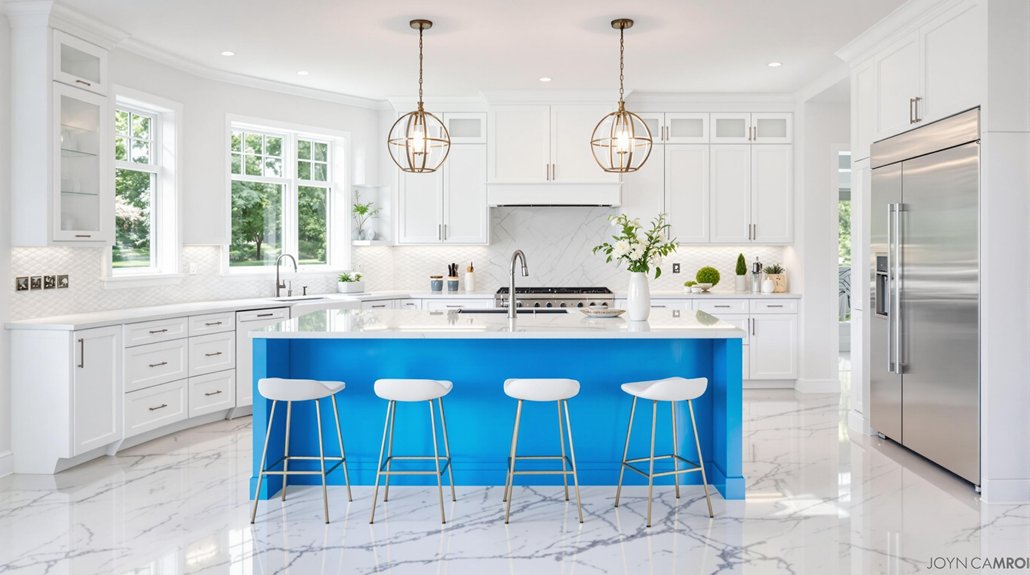
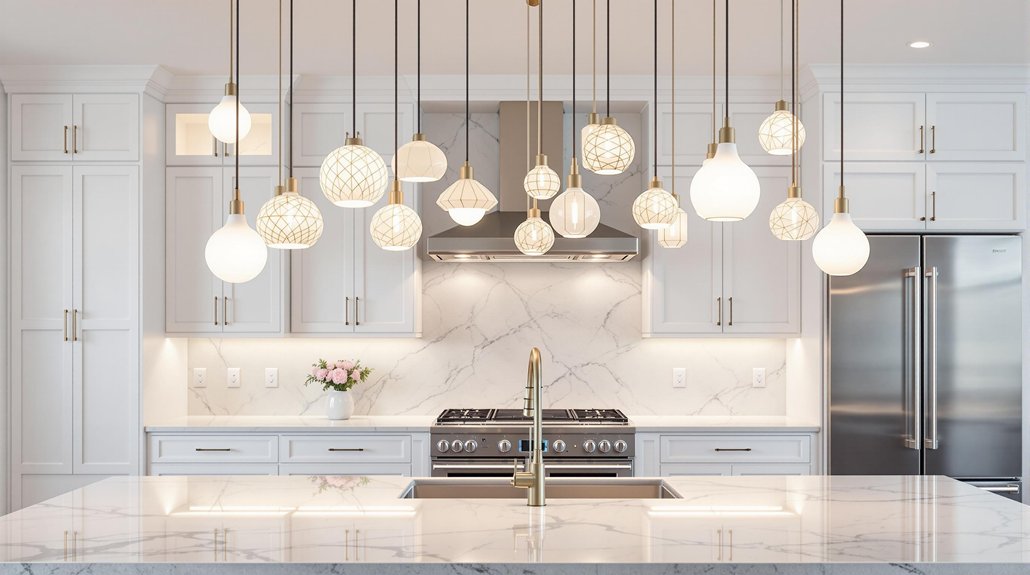
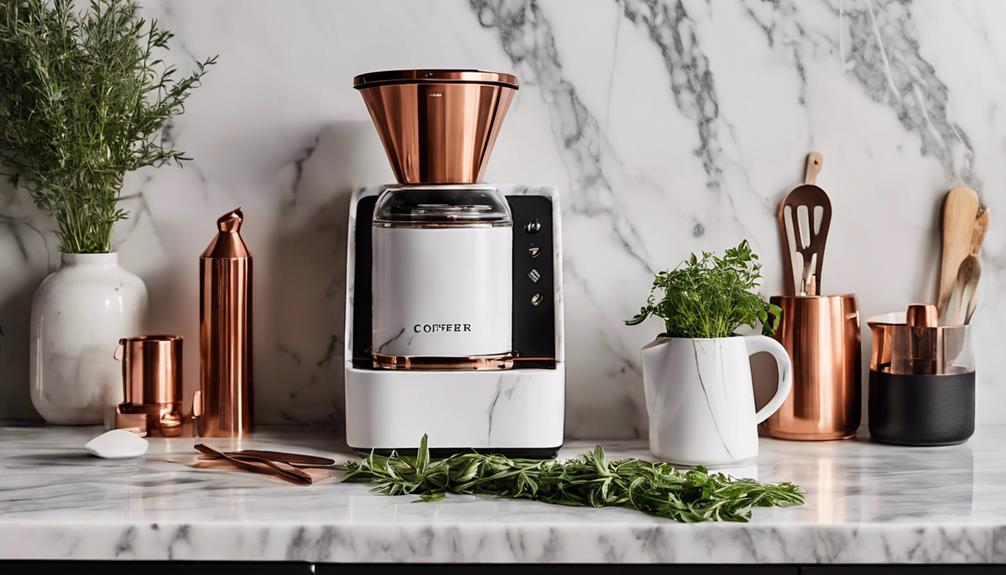
Leave a Reply